The X Button
Market Forces
by Todd Ciolek,

This edition of The X Button falls right before the Tokyo Game Show, which means that some news consists of limited pre-show leaks that may be contradicted by the actual exhibition. So forgive me if Ace Attorney Investigations 2 is reworked to be a zombie survival game.
Anyway, on to this week's irrelevancy: griping about Super Street Fighter IV's alternate costumes. Capcom displayed yet another round of new outfits for the game, and some are mundane...

...some are stylish...
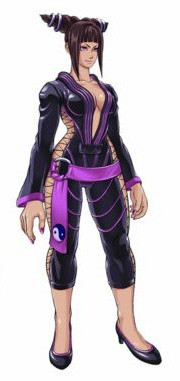
...and some are…well, look at it.
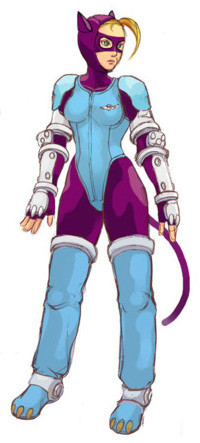
Unfortunately, a well-meaning soul made all of these costumes less impressive by posting a gallery of concept sketches for Super Street Fighter IV's alternate outfits. Most of them weren't used in the game, and most of them are better than the ones that were used. Note Juri's wardrobe, where all of the rejected costumes are superior to her dreadfully bland second costume. Not the one up above; the raver-garden-party one that I don't even care to show here.
NEWS
SQUARE READIES UNSURPRISING DISSIDIA 012 AND SEMI-SURPRISING SAGA 3
 Dissidia Final Fantasy 012 was inevitable from the moment the first Dissidia avoiding falling flat on its face, and it's not particularly shocking that Square's second Final Fantasy all-stars fighting game has an arcane subtitle like “012” or “Duodecim.” The PSP-based arena brawler does have new characters, and the first two to be announced are Final Fantasy XIII's Lighting and Final Fantasy IV's Kain. Lightning, of course, was guaranteed a spot by her starring role in the game. If the first Dissidia's depiction of Final Fantasy VI's Terra is any indication, Lightning will inexplicably turn into a meek, self-doubting wallflower for the purposes of Dissidia 012.
Dissidia Final Fantasy 012 was inevitable from the moment the first Dissidia avoiding falling flat on its face, and it's not particularly shocking that Square's second Final Fantasy all-stars fighting game has an arcane subtitle like “012” or “Duodecim.” The PSP-based arena brawler does have new characters, and the first two to be announced are Final Fantasy XIII's Lighting and Final Fantasy IV's Kain. Lightning, of course, was guaranteed a spot by her starring role in the game. If the first Dissidia's depiction of Final Fantasy VI's Terra is any indication, Lightning will inexplicably turn into a meek, self-doubting wallflower for the purposes of Dissidia 012.
Kain's inclusion suggests that this new Dissidia will include more that just main characters, a welcome change from the first game's lineup of half-boring protagonists. It's also likely that Square will add a proper hero from Final Fantasy XII. As anyone who played the game could tell you, that'd be Balthier, Ashe, Basch, or anyone but Vaan. Only limited details about the second Dissidia were revealed, but there's certain to be more shown (and played) at the Tokyo Game Show this week.
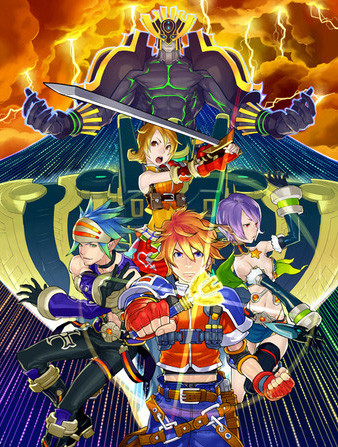
Square Enix's SaGa 3 remake is a little unexpected, as the GameBoy's third SaGa game (released here as Final Fantasy Legend III) isn't as much of a cult favorite in Japan as the second SaGa (released here as…well, you can figure it out). Perhaps the DS reimagining of SaGa 2 was just that successful. SaGa 3: Ruler of Space-Time: Shadow or Light revises a lot of the original, though, and not just by virtue of being in cartoonish 3-D. It also applies SaGa 2's storyline-manipulating concept: in SaGa 3, battles grant players Times Gear points. These in turn reveal new scenes and options in the game's plotline, which is a mass of time-travel manipulation.
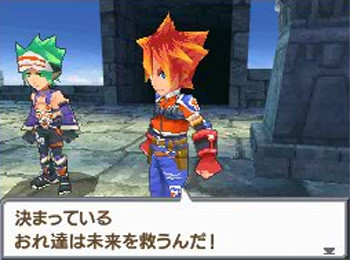
SaGa 3 used a more rigid lineup of characters in comparison to SaGa 2's blank-slate party, and the difference remains in the DS game. The heroes of SaGa 3 still consist of two humans and two beast-people, and players can customize them into creatures by feeding them monster meat or fashion them into transhumanist cyborgs and robots by giving them mechanical parts. Fans of Final Fantasy Legend III will recognize the main characters as Arthur, Sharon, Curtis, and Gloria. Of course, they were respectively named Dune, Celia, Polnaref, and Milfy in the Japanese version, and it's not known if Square would use the original names in an English version. Methinks they'd change “Milfy.”
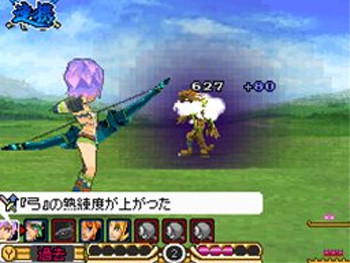
Then again, there might not even be a domestic version of SaGa 3: Ruler of Space-Time: Shadow or Light. Square Enix declined to localize SaGa 2 despite the game's fairly good reception, and America's never cared too much about the SaGa series, except when it's really bad. SaGa 3: I'm Not Typing That Whole Subtitle Again probably won't be, but players might have to import the Japanese version this winter to find out.
ACE ATTORNEY INVESTIGATIONS 2 ANNOUNCED JUST BEFORE TGS
Another unsurprising early revelation from the Tokyo Game Show is Ace Attorney Investigations 2, sequel to the Phoenix Wright spin-off that focused on prosecutor and rival Miles Edgeworth.
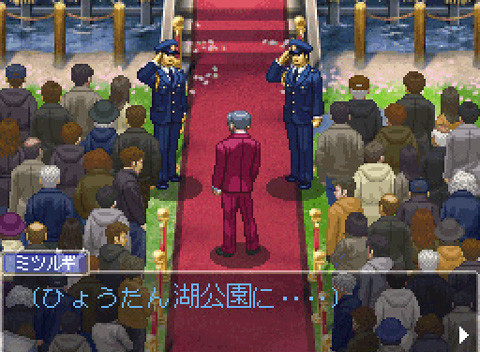
And…well, it looks a lot like Ace Attorney Investigations. Same adventure-game approach. Same visual style. Same Edgeworth being a dick to people, which is the important thing. There's also a new logic system dubbed “Chess,” though I doubt it'll prove as complicated as actual chess games. That'd take too much attention away from Edgeworth insulting various weirdos.
NEW MUSHIHIME COMING TO IPHONE
Once a niche developer of shooters, Cave fully embraced the iPhone with ports of ESPgaluda II and Dodonpachi Dai-Fukkatsu. Now Cave's backing a new Mushihime-sama title for the iPhone and iPod Touch, and the word is that it's not a port. Mushihime-sama: Bug Panic is an original creation.
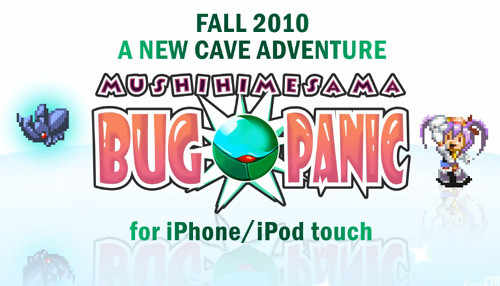
Cave's official site has only a trailer. It reintroduces Mushihime-sama leads Reco and Palm and sets up the game's shadowy antagonist, all to strains of a downright infectious theme song about, well, Bug Panic. The sprite-based art is appealing, but there's something strange about this rather vague promotion.
See, Cave actually announced Bug Panic back in January, using a trailer with actual gameplay. The Bug Panic it showed was a free-roaming overhead shooter littered with enemies, explosions, and score-boosting loot. How has Bug Panic changed since then? Cave's higher-ups evidently want us to discard that first trailer, and I can only hope the game hasn't become some routine Mushihime-themed Tetris knock-off. Whatever it is, it'll be out quite soon, if that Fall 2010 release date holds.
REVIEW: RECETTEAR: AN ITEM SHOP'S TALE
 Developer: EasyGameStation
Developer: EasyGameStation
Publisher: Carpe Fulgur
Platform: PC
Players: 1
MSRP: $19.99
Available On: Steam, Impulse, and Gamers Gate
The item shop is often the most mundane part of an RPG. Buying potions and upgrading weapons is a necessary chore, and many games view it as something to be streamlined to the point where players barely notice it. Recettear: An Item Shop's Tale does precisely the opposite. It's all about running a store in a fantasy-RPG universe, and it's far more entertaining than the premise leads one to suspect.
Young Recette Lemongrass is meagerly scraping by at the game's start. Her father ran off to become an adventurer, and her mother vanished just as at least one parent must do in every fantasy tale. Then an uptight collection-agent fairy named Tear arrives and informs Recette that she must pay back an astronomical loan taken out by her wannabe-adventurer father, or else Recette loses her house. Fortunately, Tear's nice enough to help Recette turn that house into a store, giving the girl a fighting chance at making her weekly debt payments.
Money's made several ways in Recettear, but it all comes back to Recette's shop. Items can be bought around town, acquired from desperate sellers, or picked up for free in dungeons, but they're all stocked at the store. It's there that Recette arranges her merchandise, deals with customers, expands the showroom, and decides just what market trends she'll jump on. Every buyer's open to haggling, and Recette must strike a balance between making sales and marking up the merchandise just enough to keep the loan-shark fairies at bay.
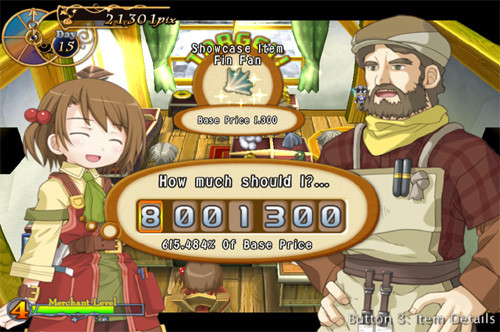
The most interesting method of acquiring goods comes from Recette's local adventurers. She meets a variety of fantasy-RPGs staples: Louie's the dim young swordsman, Charme's the hard-drinking thief, Elan's the kindly brawler-priest, Caillou's the boy magician, Tielle's the elf archer, Nagi's the half-asleep spearwoman with no sense of direction, and Arma's the clueless robot girl. As she meets more explorers, Recette contracts them to trek through dungeons, with the hired help slaying monsters while a protected Recette and Tear follow close behind.
Recettear is an intriguing creation even in its history. EasyGameStation released it in Japan's indie circles back in 2007, and the game seemed to sink into the same never-translated oblivion that's claimed Japan's good doujin games and God-awful crap alike. Translation studio Carpe Fulgur grabbed Recettear for their first project, though, and it's not hard to see why. It's a charming and surprisingly complicated piece of RPG candy.
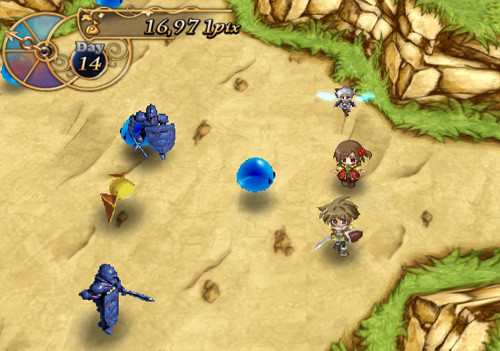
Neither half of Recettear would quite stand on its own. The questing segments are simplistic and repetitive, with limited character progression, simple attacks and the same randomly generated squares of labyrinth found in any middling dungeon hack. The retail scenes are more inventive, though the back-and-forth of buying, selling, and haggling gets old when it goes uninterrupted. Join the two games together, though, and Recettear is marvelously compelling. Each foray through a dungeon brings up another round of rarities and free loot to sell, and Recette's trips around town put her in touch with new characters to join her on treasure raids.
It helps that Recettear isn't easy, despite its resemblance to pushover RPGs like Rhapsody: A Musical Adventure. The payments get higher and higher as the weeks go by, and Tear doesn't cut any breaks for the first installment. The mazes are also nasty enough to kill players early on, though dying isn't quite as punishing at it is in more dedicated dungeon hacks; fallen adventurers can be whisked off to town with one item in their clutches. In fact, the game expects players to fail early on, and running out of money results in a dream sequence that lands Recette back on the second day of her merchant odyssey, with all of her salable items intact. She still confronts a cardboard-box future, though.
An indie game it may be, but Recettear doesn't look so much more primitive than a lot of the anime-splashed PlayStation 2 RPGs put out by NIS America. The character sprites and the 3-D work are basic, and the art's all in line with modern “moe” standards. The limited budget shows only in the cracks, particularly when a character's big-headed sprite stays put even after the dialogue indicates that he or she has left the scene. There's only limited voice acting as well, and it's all still in Japanese. It takes the story in familiar directions, right down to the cackling rich-girl rival whose failed schemes leave Recette more confused than humiliated.
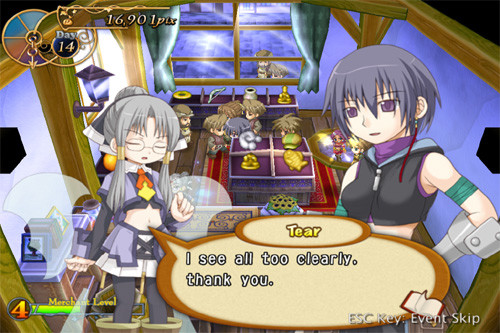
Recettear requires a high tolerance for aggressively adorable characters. Recette is endearing naïve, Tear is constantly exasperated, and every supporting character has some apparently winsome personality hiccup. In fact, even the elderly customers have that big-eyed look to them. It can be a bit much, though at least the game's innocent about everything. While I have no doubt that it'll attract a share of creepy fans, Recettear itself is cute simply to be cute and not to sate the fantasies of shut-ins.
And it isn't Recettear's story or artistry that makes it a pleasure. It's the interplay between RPG questing and studious shop-keeping, all covered by an amusing localization. For a first-time effort, Carpe Fulgur's script is easily on par with the better work of Atlus or Aksys Games (with flourishes of Working Designs' modern references). It's respectful to the main storyline, but the dialogue's peppered with the sort of careful little details (and French profanity) that separate a good translation from a merely adequate one. The only really annoying part of the game remains its soundtrack; it's mostly straight from Infectious Stock Japanese RPG Music Volume 16, and I suggest keeping it low unless you want to go stark raving mad.
Recettear: An Item Shop's Tale is more demanding that it first appears, both in its challenges and its occasional overdose of pure-strain cute cute CUTE. Yet no one should be scared off by the seemingly dull premise or the saccharine artwork, because there's a fantastic little game inside. Recettear may look like countless other disposable RPGs with limited audiences and questionable taste, but it's really the sort of unique addiction that the game industry needs.
NEXT WEEK'S RELEASES
CLADUN Developer: NIS
Developer: NISPublisher: NIS America Platform: PlayStation Network Players: 1-4 MSRP: $19.99 Cladun: This is an RPG might mislead us with the “classic dungeon” part of its title. After all, dungeon-hack games of the alleged classic era barely had any plots, and CLAssic DUNgeon actually starts off with several minutes' worth of storyline about two adventurers, Pudding and Souma. They stumble into a pocket dimensional that holds a reclusive witch, a talking cat, strange secrets, and, of course, a multi-level dungeon. And then Cladun spits on the plot by giving players the chance to walk through a certain door and see the game's ending, just like that. Cladun embraces a retrograde style in its looks, though, as everything's shown in deliberately primitive pixel-by-pixel art, and the player can even make his or her own characters and bosses in such a fashion. Combat is speedy in its dungeon-hack way, with various puzzles, bosses, and a few traps that aren't always harmful. It's further enhanced by a positioning system that controls where supporting characters stand and how they gain levels. Four players can join in the game over ad-hoc, and NIS makes no promises about how crude the player-made avatars can get.
|
ETRIAN ODYSSEY III: THE DROWNED CITY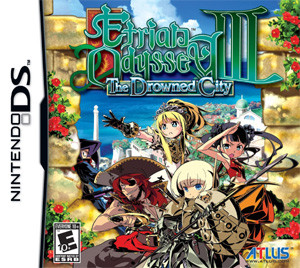 Developer: Atlus
Developer: AtlusPublisher: Atlus Platform: DS Players: 1 MSRP: $29.99 Yes, it's a good week for dungeon hackery, and Etrian Odyssey is part of the series that reinvigorated the genre on these shores. The Etrian Odyssey titles are vicious little dungeon forays carried out by cute, player-created avatars in modern anime styles, and The Drowned City ventures toward the open sea. Of course, Etrian Odyssey still needs dungeons, so the game's set on an island surround by partly submerged ruins. That's where players must guide a party of customized characters, which include such new classes as the farmer and the buccaneer. Battles remain menu-based contests of planning and level-gaining, and the series still insists that players map out dungeons using the stylus, just like a past generation used graph paper cartography for Phantasy Star and The Bard's Tale. It's a dungeon hack, after all.
|
discuss this in the forum (27 posts) |
this article has been modified since it was originally posted; see change history